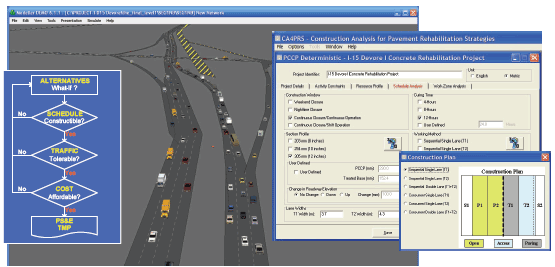CA4PRS Software, December 19, 2008 FHWA-Endorsed Technology and Free Group-license for All 50 State DOTs CA4PRS
A Tool for Integrated Schedule-Traffic-Cost Analysis for Highway Projects
Most state highways in the United States were built during the 1960s and 1970s and have exceeded their design lives, which has motivated the transportation agencies responsible for them to shift focus from construction of new highways to the rehabilitation of existing facilities. Because highway rehabilitation projects often cause congestion, safety concerns, and limited access for road users, agencies face a challenge in finding economical ways to renew deteriorating roadways in metropolitan areas.
One innovation in the effort to reduce highway construction time and its impact on traffic is software called CA4PRS, Construction Analysis for Pavement Rehabilitation Strategies. CA4PRS is a decision-support tool for transportation agencies that helps in selection of the most effective and economical strategies for highway maintenance and rehabilitation projects. Funded through an FHWA (Federal Highway Administration) pooled-fund, multistate consortium (CA/MN/TX/WA), CA4PRS was developed by the Institute of Transportation Studies of the University of California, Berkeley, with technical collaboration from the FHWA Turner-Fairbank Highway Research Center.
The program incorporates three interactive analytical modules: a Schedule Module that calculates project duration, a Traffic Module that quantifies the impact (delay) of work zone lane closures on the traveling public, and a Cost Module that estimates total project cost.
Benefits of CA4PRS
Demonstrations have shown that CA4PRS is user-friendly, easy to learn, and valuable in any project phase. CA4PRS users can evaluate "what if" scenarios for alternative rehabilitation strategies, including pavement cross-sections and material types, construction windows and lane closure tactics, and contractor logistics and constraints.
CA4PRS has helped agencies, contractors, and consultants save engineering time, improve estimate accuracy, and streamline team work in preparing PS&E and TMP packages. CA4PRS results can also be integrated with traffic simulation models to quantify the impact of work zone lane closures on the entire highway network, including local arterials and neighboring freeways. CA4PRS enhancements in development include analyzing strategies for roadway widening (version 2.5) and bridge/interchange replacement (version 3.0).
Implementation Experience
Since 1999, the capabilities of CA4PRS have been confirmed on several major highway rehabilitation projects in several states including California, Washington, and Minnesota. The software was validated on the I-10 Pomona Project, in which 2.8 lane-km of concrete pavement were replaced in one 55-hour weekend closure. The software was also used to develop a construction staging plan for the I-710 Long Beach Project, in which 26 lane-km of asphalt concrete were reconstructed in eight 55-hour weekend closures.

Shown above: the CA4PRS framework (left), user interface (right), and microscopic traffic simulation (center).
More recently, CA4PRS was used with traffic simulation models to select the most economical rehabilitation scenario for the I-15 Devore Project (see table on the next page). The 4.5-km concrete pavement reconstruction project, which would have taken 10 months using traditional nighttime closures, was completed over two 9-day periods using one-roadbed, continuous closures with counterflow traffic and around-the-clock construction. Implementing continuous closures rather than repeated nighttime closures in this project resulted in significant savings: $6 million in agency costs and $2 million in road user costs.
Other sponsoring state transportation departments have also used CA4PRS for analyses of corridor rehabilitations, including the reconstruction of Interstate 5 through Seattle (WA) and the rehabilitation of Interstates 394 and 494 in St. Paul (MN).
| Construction Alternative | Schedule Comparison | Cost Comparison ($M) | Max. Delay (Min.) | |||
|---|---|---|---|---|---|---|
| Total Closures | Closure Hours | User Delay | Agency Cost | Total Cost | ||
| Continuous (24/7) Closure | 2 | 400 | 5.0 | 15.0 | 20.0 | 80 |
| 72-Hour Weekday Closure | 8 | 512 | 5.0 | 16.0 | 21.0 | 50 |
| 55-Hour Weekend Closure | 14 | 770 | 14.0 | 17.0 | 31.0 | 80 |
| 10-Hour Nighttime Closure | 220 | 2,200 | 7.0 | 21.0 | 28.0 | 30 |
Nationwide Outreach
Throughout the U.S., there is growing recognition of the capabilities and benefits of CA4PRS. It has been presented at national conferences hosted by the TRB, AASHTO, and FHWA, and articles about it have been published in professional journals and transportation magazines such as TR News, FOCUS, and Public Roads, as well as in industry newsletters. To expedite use of the software statewide, Caltrans IT, a lead agency in its development, recently approved CA4PRS as a standard tool and has undertaken its group installation on engineers' workstations. Approximately 800 transportation engineers in 10 state DOTs have received CA4PRS hands-on user training. On the academic side, approximately 10 U.S. universities currently use CA4PRS for highway research and teaching.
As a recent research payoff, CA4PRS won a 2007 Global Road Achievement Award granted by the International Road Federation (IRF). In addition, the AASHTO Technology Implementation Group (TIG) is focusing on CA4PRS for nationwide promotion to its state members. FHWA also formally endorsed CA4PRS as a "Priority, Market-Ready Technologies and Innovations" product in 2008, and recently acquired an unlimited CA4PRS group license for all 50 state DOTs to deploy the software nationally.
For More Information
Ken Jacoby, FHWA Office of Asset Management
(202) 366-6503
ken.jacoby@dot.gov
Dr. Nadarajah Sivaneswaran (Siva)
FHWA, Turner-Fairbank Highway Research Center
(202) 493-3147
nadarajah.sivaneswaran@fhwa.dot.gov
Michael Samadian, Project Manager
Caltrans Division of Research and Innovation
(916) 324-2048
michael_samadian@dot.ca.gov
Dr. Eul-Bum (E.B.) Lee, Principal Investigator
University of California, Berkeley (ITS)
(510) 665-3637
eblee@berkeley.edu
On the Caltrans Web:
www.dot.ca.gov/hq/research/roadway/CA4PRS/index.htm

